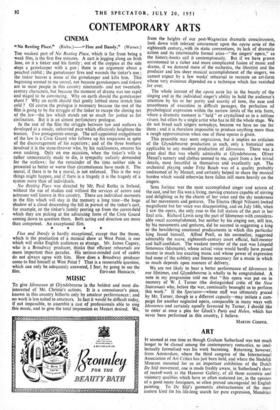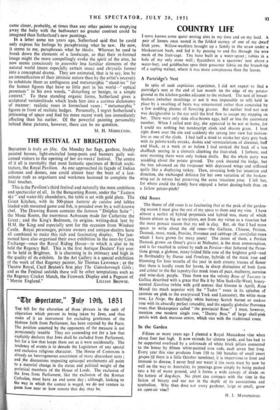ART
IT seemed at one time as though Graham Sutherland was not much longer to be classed among the contemporary romantics, so intel- lectually formalised was his work becoming. Returning, however, from Amsterdam, where the third congress of the International Association of Art Critics has just been held, and where the Stedelijk Museum mounted for us an important exhibition of the Dutch De Stijl movement, one is made freshly aware, in Sutherland's show of recent work at the Hanover Gallery, of all those eccentric and visionary qualities which have so often sustained (or, in the opinion of a good many foreigners, so often proved uncongenial in) English painting. To De Stijl's geometric abstractionism of the most austere kind (in his life-long search for pure expression, Mondrian
came closer, probably, at times than any other painter to emptying away the baby with the bathwater) no greater contrast could be imagined than Sutherland's new paintings.
In a letter some ten years ago, Sutherland said that he could only express his feelings by paraphrasing what he saw. He now, it seems to me, paraphrases what he thinks. Whereas he used to break down the elements of a landscape, so that their re-formed Image might the more compellingly evoke the spirit of the area, he now seems consciously to assemble less familiar elements of the natural world (more especially certain insect and chrysalis forms) into a conceptual drama. They are animated, that is to say, less by an intensification of their intrinsic nature than by the artist's necessity to substitute them as ambiguous and metamorphic "stand-ins " for the human figures that have so little part in his world—" optical presences " in his own words, " disturbing or benign, in a simple context." To these standing organic forms, Sutherland gives a sculptural verisimilitude which leads him into a curious dichotomy of manner: realistic roses in formalised vases ; " metamorphic " figures in front of realistic hedges. Personally, I regret Sutherland's jettisoning of space and find his more recent work less immediately affecting than his earlier. Of the powerful painting personality behind these pictures, however, there can be no question.
M. H. MIDDLETON.



































 Previous page
Previous page